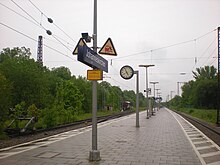Johanneskirchen (Munich)

Johanneskirchen is a district of the Bavarian capital Munich and belongs to the city district 13 Bogenhausen .
location
Johanneskirchen is located on the northeastern edge of the Bogenhausen district and thus also the city of Munich. The Johanneskirchener Moos is also where the largest open spaces in the district are located, which are mainly used for agriculture.
The historic core of Johanneskirche is to the east of the Munich-Airport S-Bahn line , but the district also includes new development areas west of the railway line.
In the north and east, the city limits to Unterföhring and Aschheim also form the border of Johanneskirche. In the west the Cosimastraße - Johanneskirchener Straße - Ringofenweg forms the border to Oberföhring , in the south Fideliostraße - Stegmühlstraße - Salt Road separate Johanneskirchen from Englschalking and Daglfing .
history
The oldest document mentioning John Kirchen found in a traditional note of the Bishopric Fresing from the year 815, in which the Church of St. John the Baptist ( " ecclesia Sancti Johannis ad Feringa ") is called. It also mentions the beer (" cervisa ") that the local deacon Huuezzi had to deliver to the Fresingen Episcopal Church.
In the 12th century Johanneskirchen came from Freising's rule to the Wolfratshausen nursing court . In 1496 the place became a Hofmark of the Munich patrician family Ridler , which they had taken over from the Sentlinger and expanded around 1500 by further Freising fiefdoms in Unterföhring and Putzbrunn . Until the secularization of 1803, the Hofmark area was enclosed on three sides by the Freising Monastery, only to the east was free access to the Duchy / Electorate of Bavaria.
When the community was formed in Bavaria in 1818 , Johanneskirchen became an independent community, and in 1820 it became part of the community of Daglfing . In 1893 an attempt to be reassigned from Daglfing to Oberföhring failed. On January 1, 1930, Johanneskirchen was incorporated into the city of Munich as part of the Daglfing community.
As in all of north-east Munich, there were many brickworks in Johanneskirchen towards the end of the 19th century that burned the clay bricks extracted here for the brisk construction activity in Munich.
In the 1960s and 1980s, large new districts emerged in Johanneskirchen.
Townscape
The historical core of Johanneskirchen is still characterized by a village. Farms surrounded as fortified church built village church of St. John the Baptist from the 13th century. The agriculturally used areas of the Johanneskirchener Moos already adjoin this village center .
Half a kilometer to the east is the Johanneskirchen garden city , built between 1984 and 1986, with single, double and terraced houses between which there are extensive green spaces. To the east is the Zahnbrechersiedlung , built from 1933 onwards .
West of the railway line are the new development areas Johanneskirchen Nord (1964–1968) and Johanneskirchen West (1988–1999) with their apartment blocks.
traffic
The Munich East – Munich Airport railway runs through Johanneskirchen, separating the historic center and the new development areas in the west. It is served every 20 minutes by the S8 line of the Munich S-Bahn from Herrsching to the airport . The Munich-Johanneskirchen S-Bahn station has two platform tracks on a central platform , the access to which is not barrier-free. There is also a siding that is used for shunting trips to the northern heating plant . The siding to the thermal power station and the Munich Nordring branch off the S-Bahn line between Johanneskirchen and Unterföhring .
Johanneskirchen is also connected by bus routes 154 (Nordbad) and 50 (Olympia shopping center).
Individual evidence
- ↑ Theodor Bitterauf: The Traditions des Hochstift Freising , Vol. 1: 744–926 (Sources and Discussions on Bavarian History NF 4). Munich [u. a.] 1905, p. 300, no. 351.
- ^ Hannes Obermair : Tirolensia in the National Museum in Prague. In: Preservation of monuments in South Tyrol 1991–1995. Published by the Bolzano Regional Monuments Office. Folio-Verlag, Vienna-Bozen 1997, pp. 277–290, reference pp. 277–278.
- ^ Wilhelm Volkert (ed.): Handbook of Bavarian offices, communities and courts 1799–1980 . CH Beck, Munich 1983, ISBN 3-406-09669-7 , p. 601 .
literature
- Willibald Karl (Ed.): Villages on the brick land . Daglfing-Denning-Englschalking-Johanneskirchen-Zamdorf. Buchendorfer, Munich 2002, ISBN 978-3-934036-90-1 .
Web links
- Johanneskirchen on the website of the Association for District Culture in the Munich Northeast eV
Coordinates: 48 ° 10 ' N , 11 ° 39' E

